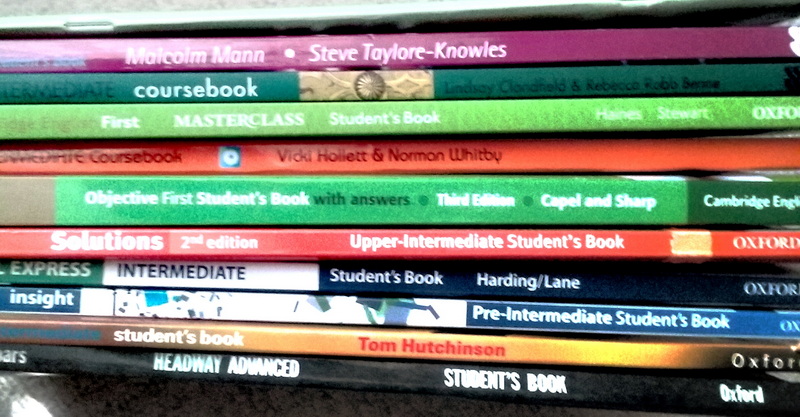Looking for a Coursebook
By David Shaffer
A new session is beginning at your school, and you need to select a coursebook for the EFL course that you will be teaching. What to do? Go to the ELT bookstore in your area to check out the coursebooks available. It would be easier to go online to look for and look at books, but online samples are very limited in scope, and at a bookstore you have all the books in one place to easily make comparisons. And you have bookstore staff to answer any questions that you may have.
General Appearance
So, now that you are at the bookstore, what do you look for in a coursebook best suited for the class of students that you will be teaching? You pick up a book and start flipping through it, checking if its general appearance is appealing. Is it appealing to you? That is important, yes, but also ask yourself if you think it will be appealing to your students, as the lack of visual appeal can negatively affect student motivation. Is the coursebook up to date? You can check the copyright date, but even if that is recent, the contents may not be. If you see words in the text such as blackboard, tape recorder, pager, and floppy disk, it likely is dated in content. Looking at the description that a coursebook has of itself – often on the back cover – can be helpful, but also check if the contents match that carefully crafted and appealing cover hype.
If you are satisfied with all of the above, are you ready to make a decision? Do not rush. As you have the book in hand, check its technical qualities. Will it survive the course in good condition: strong cover, quality paper? Is the print easy to read for the level of students? Are the color illustrations and general layout appealing – not just for you but from a student point of view?
Appropriateness
All seem quite acceptable? Good, but do not head to the cashier yet. Remember that the selection of the best coursebook available will make teaching for you and learning for your students much more enjoyable and efficient. If you are teaching in this part of the world – in Korea, for example – check on the culture aspects of the coursebook. Since many of the major ELT publishing houses are Western based and many authors are Western oriented, it is easy for coursebooks to have an overly Western weight. Do the characters in the book include people who your students can identify with and cultural aspects that they are familiar with?
If the cultural aspects are appropriate, we might next look at the appropriateness of the materials in the lessons. A unit on love and marriage (“Aargh!”) may not be appealing to young learners, and they may not be eager to roleplay an elderly person. Is the language focus – the vocabulary items, chunks, and structural patterns – at the appropriate level for your students’ proficiency? Also, check on the appropriateness of the activities in the lessons. Would a class of adult beginners want to be singing the Alphabet Song to learn their ABCs?

Motivating Materials
Motivation is a major factor in language learning. Though much motivation can be instructor related, much can also come from the coursebook selected. Are authentic or near-authentic materials still at the students’ proficiency level, and are they current in content? Are the materials intrinsically interesting – Would the students be, for example, more interested in country-western music or K-pop? Do the materials relate to the students’ lived experiences? Is there a lot of variety in topics and in the pace of activities? Especially with young learners, it is helpful to have rapidly moving activities interspersed with more sedentary ones (“stirrers” interspersed with “settlers”) for classroom management. Are the activities interactive – not just interactive with the teacher but with student-to-student interaction, and possibly interaction with the community? Are the activities of a problem-solving nature (such as task-based activities), and do they encourage autonomous learning?
Methodology
Check on the methodology, or methodologies, that the coursebook espouses. Does it follow a currently widely accepted methodology such as task-based learning or project-based learning, or an eclectic combination, as opposed to an outdated methodology such as the audio-lingual method of the 1960–1970s? Is the methodology one that students are familiar with or can easily adapt to? Korean students, for example, are more accustomed to being passive participants in the classroom rather than interacting and collaborating with others in problem-solving activities.
Macro- and Microskills
The balance among the macroskills – listening, speaking, reading, and writing – and the balance among the microskills – pronunciation, vocabulary, grammar, spelling, etc. – as well as the balance between the macro- and microskills is also an important consideration in coursebook selection. Although whole language learning is promoted these days, it is often the case that a teacher will be required to teach a course on one of the macroskills, such as writing. In such a case, too, it is important that the coursebook incorporates reading, listening, and speaking skills to a certain degree. In Korea, due to the influence of outdated teaching methods, young learner materials often get an inordinate amount of emphasis on grammar. Check that the coursebook in hand does not do this and that is does provide an appropriate balance among the language learning skills for your course and for your students. One skill that teachers and coursebooks often overlook is language learning strategies. Check that the coursebook also introduces helpful strategies for the students to employ to become more efficient and more autonomous language learners.
Another balancing act that a good general EFL coursebook will succeed at is between fluency and accuracy activities. Both are quite necessary but should not interfere with each other; for instance, the correction of grammar errors should not be a major concern when the focus of an activity is on improving spoken fluency. Communicative strategies are also important for students to learn to become effective communicators. Knowing when and how to change the topic of conversation or when and how to interject oneself into another’s ongoing utterance is both a linguistic and social skill. A good coursebook will also introduce such strategies.

Introducing…
Check how new material, whether vocabulary or grammar, is introduced in the coursebook. To be most effective, it will be introduced in a context, making it easier to understand and easier to remember. Check also if there are sufficient activities to practice the new material and if that material is recycled in subsequent units. The gradation in the introduction of new material should be gradual, not too quickly increasing in degree of difficulty, yet not too slow. For example, one would not want their coursebook to introduce eat and drink in one lesson and jump to vocabulary such as appendicitis and colectomy in the next.
Interaction
The importance of interaction should not be underestimated. After all, language use is the interaction of two or more persons. While some individual work is useful in the classroom, we would like for a coursebook to put focus on pair work, group work, and even whole-class work where students interact in true dialogue to communicate a real message. Such interaction also creates a sense of community which, in turn, creates a more non-threatening environment for the students.
Assessment
What coursebooks often lack are forms of student assessment. These could include self-assessment in the form of can-do statements, where students check off language skills that they have achieved as they achieve them, or periodic checks on new material in the form of quizzes. Coursebooks need to offer students some form of feedback so that the learner can recognize and measure their language learning improvement.
Wait!
So, that EFL coursebook that you picked up seems to adequately fulfill the requirements set out above. But do not make your coursebook decision just yet. There are other coursebooks for the same proficiency level by different publishers – and often by the same publisher – in the bookstore for you to scrutinize and compare. If the coursebook selection is small, you may wish to visit several other bookstores to make your book comparisons, including price comparisons. Once you are satisfied that you have conducted a good comparison and made the best decision, then it is time to walk up to the counter and arrange with the attendant the coursebook for your class. The attendant will be glad, and in the end, you will be gratified, and your students will be pleased.
Credit: Thinking image – Freepik.com
Gwangju-Jeonnam KOTESOL Upcoming Events
Gwangju-Jeonnam Chapter Workshop
- Topic: Linking Photography with Teaching
- Date: March 11, 2023
- Venue: Gwangju National University of Education
Check the Chapter’s webpages and Facebook group periodically for updates on chapter events and other online and in-person KOTESOL activities.
For full event details:
- Website: http://koreatesol.org/gwangju
- Facebook: Gwangju-Jeonnam KOTESOL
The Author
David Shaffer has been involved in TEFL, teacher training, writing, and research in Gwangju for many years, almost totally as a professor at Chosun University. As vice-president of the Gwangju-Jeonnam Chapter of KOTESOL, he invites you to participate in the chapter’s teacher development workshops and events (online and in person), and in KOTESOL activities in general. Dr. Shaffer is a past president of KOTESOL and is currently the editor-in-chief of the Gwangju News.







